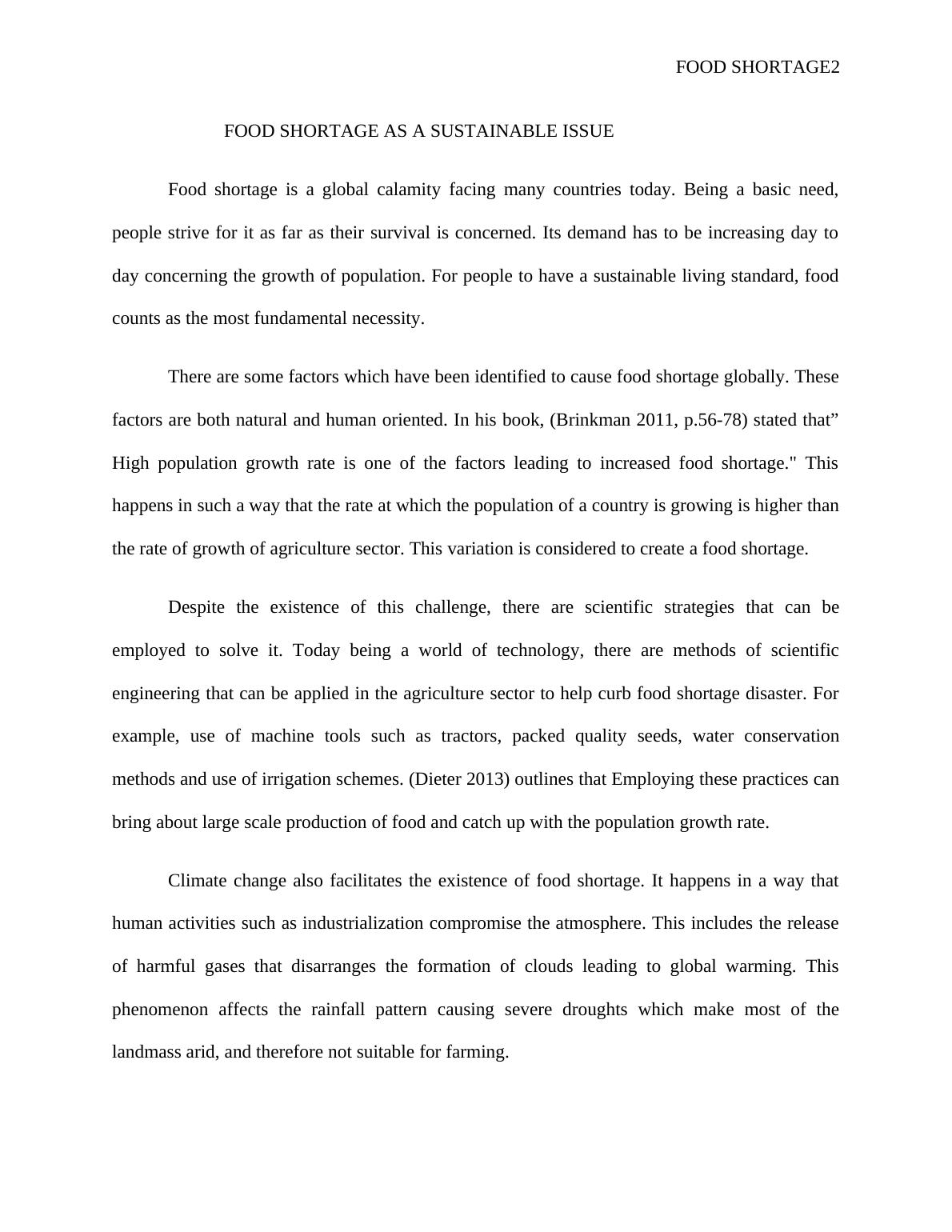Food Shortage- Global Calamity
Added on 2020-02-24
6 Pages1183 Words67 Views
FOOD SHORTAGE1FOOD SHORTAGE AS A GLOBAL CALAMITYCourse nameProfessor’s nameUniversity nameCity, stateDate of submission

FOOD SHORTAGE2FOOD SHORTAGE AS A SUSTAINABLE ISSUEFood shortage is a global calamity facing many countries today. Being a basic need,people strive for it as far as their survival is concerned. Its demand has to be increasing day today concerning the growth of population. For people to have a sustainable living standard, foodcounts as the most fundamental necessity.There are some factors which have been identified to cause food shortage globally. Thesefactors are both natural and human oriented. In his book, (Brinkman 2011, p.56-78) stated that”High population growth rate is one of the factors leading to increased food shortage." Thishappens in such a way that the rate at which the population of a country is growing is higher thanthe rate of growth of agriculture sector. This variation is considered to create a food shortage.Despite the existence of this challenge, there are scientific strategies that can beemployed to solve it. Today being a world of technology, there are methods of scientificengineering that can be applied in the agriculture sector to help curb food shortage disaster. Forexample, use of machine tools such as tractors, packed quality seeds, water conservationmethods and use of irrigation schemes. (Dieter 2013) outlines that Employing these practices canbring about large scale production of food and catch up with the population growth rate. Climate change also facilitates the existence of food shortage. It happens in a way thathuman activities such as industrialization compromise the atmosphere. This includes the releaseof harmful gases that disarranges the formation of clouds leading to global warming. Thisphenomenon affects the rainfall pattern causing severe droughts which make most of thelandmass arid, and therefore not suitable for farming.

FOOD SHORTAGE3Trying to remedy this phenomenon, there are systematic ways that can be applied tosolve it. Conservation of the environment is a key factor that tries to solve unreliable climatechanges. Like it has been observed earlier, there is a design in which the industrialization processcan be approached and limit emissions leading to climate changes. For example using alternativebiofuels in industries that have little or no emissions can control climate changes. A study by(Ison 2007, p.499-511) found that When these measures are observed the climate pattern can bemaintained and improved. Through this, water shortage can be eliminated therefore influencingsteady food production.Change of taste and preferences is another encounter that has facilitated exhaustion ofsome agriculture production processes. This is happening such that as the population grows, itsdiet preferences change too. It simply means people mostly in urban areas have opted toconsume processed and canned foods including meat and dairy. According to ( Maloni 2006,p.35-52) The effect of this to the agriculture sector is that for the farmers who engage inagriculture for commercial purposes they are likely to shun away from it when the market is notpositively responding. This effect undermines the agriculture sector regarding labor and attitude,therefore, leading to food shortage since large scale production becomes limited.To ensure that plenty of food is there for current and future consumption, people canstandardize their consumption such that cooked food is not undermined. In his journal, (Walker2007, p.1989-1993 ) attributes that the government can also amend initiatives that tend to fundfarming practices and keeping it steady all the time. For example, it can fund farming societiesby purchasing their products and providing them with quality farming necessities such asfertilizers and sprinklers.

End of preview
Want to access all the pages? Upload your documents or become a member.
Related Documents
Climate Change and Food Insecurity in Nepal: A Case Studylg...
|13
|3373
|215
Environmental Management for Sustainable Developmentlg...
|16
|4417
|35
Australian Water Crisislg...
|5
|1476
|478
Food Sustainability Measures And Metriceslg...
|5
|1415
|16
Moisture Loss in Post-Harvest Fruits and Vegetables: Effects of Temperature, Humidity, and Surface Coatinglg...
|19
|3559
|430
GLOBAL CLIMATE AND FOOD SECURITYlg...
|9
|2162
|18